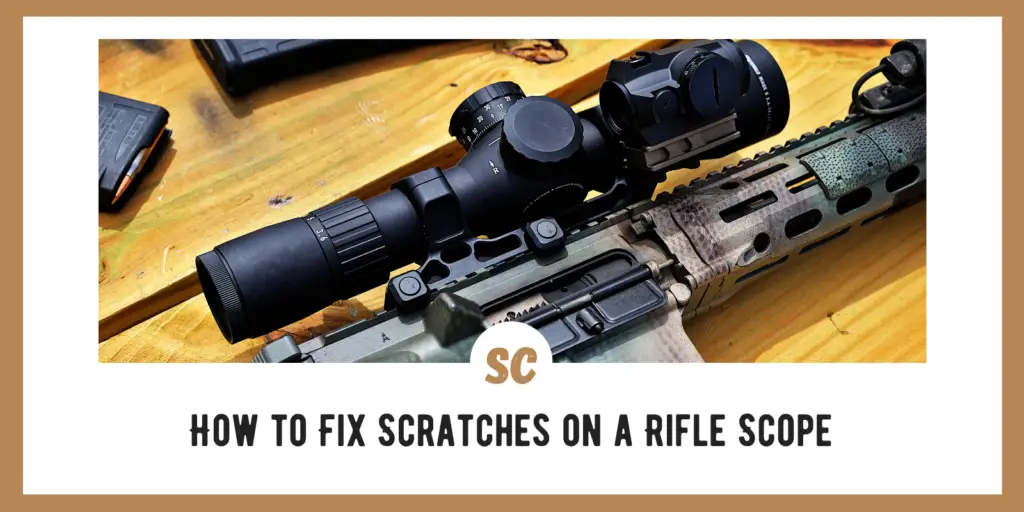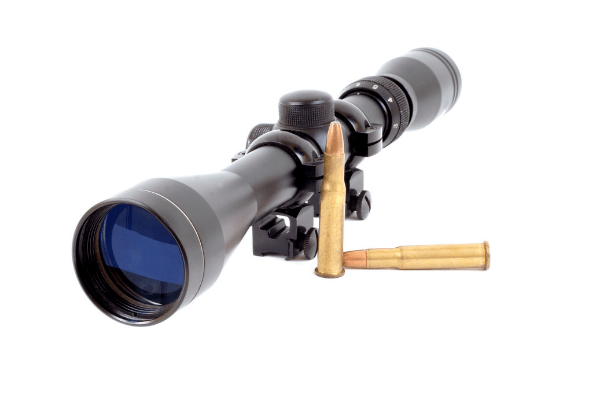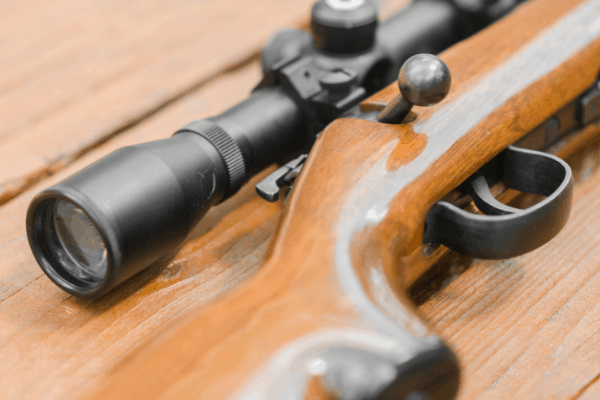Riflescopes are funny things. We all know that they are tools that we regularly use to perform certain jobs. Like any tool, riflescopes are subject to wear and tear on a normal basis. This normal wear and tear often result in the visible signs of that use in scratches. We all like to keep our scopes and rifles in tiptop shape. Many shooters wonder about how to fix scratches on a riflescope.
Scratches on riflescopes come in many different forms and severities. Scratches may occur on the body and tube of the scope or the lenses. Surface scratches on the tube and body of the scope are usually minor and easily repaired. Lens scratches are another matter and often render a riflescope unrepairable and unusable.
Some shooters see the minor scrapes and dings on their rifle scopes as reminders of their enjoyed outings. Each scratch or dent is a memory of a great time or a memorable event. Other shooters prefer to keep their rifles and rifle scopes in pristine condition. Dings and scratches require quick attention and repair to keep that perfect look.
SKIP AHEAD
The Riflescope Tube and Housing – Attending to the Scratches
A key step in remedying scratches on the tube of a riflescope is a basic understanding of riflescope construction and finishes. Different materials and different finishes require different approaches to refinishing or repairing scratches.
Aluminum Scope Tubes and Bodies
Most new riflescopes use several aluminum alloys for the riflescope tubes. The finish on these aluminum products is an anodizing process that is nearly impossible to reproduce outside the factory. The best you can hope for is a touchup that is a close match to the original finish. Some solutions used by experienced shooters include the following:
- Black Permanent Markers – You can effectively hide some very minor scratches using a black permanent marker. Black permanent marker is especially good on blued surfaces. However, most scope tubes are aluminum, and the black permanent marker may not match the black anodized finish on the aluminum tube. The black permanent marker is not as permanent as it may sound and can soon wear off, exposing the scratch once again.
- Cold Bluing – Some shooters have had good results using cold-bluing pens. These cold-bluing pens are for touching up scratches and blemishes on blued steel parts of rifles and shotguns. Some aluminum alloys will take the cold-bluing while others do not accept the color, and it wipes off as soon as it dries. Color matching is another problem with using cold-bluing products on aluminum.
- Aluminum Blackening Agents – Fairly new to the market are some aluminum blackening agents that mimic the anodizing process of the original finish. Users of these products report mixed results. One important part of using these products is removing oxidation from the bare aluminum you are treating. Removing this oxidation that occurs within seconds of exposure of the bare metal to air can be difficult on small, deep scratches without further damage to the riflescope.
- Factory Refinishing – Some of the better-scope manufacturers will refinish a badly scratched or dented riflescope to factory-fresh condition. Some riflescope manufacturers offer warranties that cover the repair of surface blemishes and damage. Check with the manufacturer of your scope for more detailed information.
Steel Scope Bodies
In the past, manufacturers used steel in many older scopes and other optical instruments. In most cases, the steel bodies of these riflescopes were blued just like the metal parts of most rifles and shotguns. Repairing surface blemishes on these parts is like repairing a scratch on a blued shotgun or rifle finish.
We don’t suggest hot bluing a riflescope due to the delicate character of the internal parts of a riflescope, such as the seals and O-rings. However, many new cold-bluing products effectively repair and hide surface blemishes on steel tube riflescopes. Follow the cold-bluing product’s instructions carefully to get the best possible results.
Lens Scratch Solutions
Most modern scope manufacturers protect the lenses on their riflescopes and other optics with multi-layer systems. These lens coating systems are usually proprietary to the manufacturer and are closely guarded secrets. A scratch on a riflescope lens is beyond the capability of most shooters to repair.
Lens Coatings – A Primary Introduction
Almost every manufacturer offers various lens coatings depending on the quality of the riflescope they are offering. In general, riflescope lens coatings fall into four areas:
- Coated Lenses – A riflescope advertising having a coated lens usually only has a single coating on one lens. You generally find this type of coating option on the lower end of the riflescope quality scale.
- Fully-Coated Lenses – Fully-coated riflescope have all the external glass surfaces of the riflescope coated with protective layers. Fully-coated lenses are the standard on most mid-range scopes.
- Multi-Coated Lenses – Better riflescopes will feature multi-coated lenses. A riflescope noted as having multi-coated lenses usually has one lens surface with multiple coatings to protect the lens and enhance the image quality. These multiple coatings are layered and usually applied sequentially at the factory.
- Fully Multi-Coated Lenses – If all the external glass on your riflescope had multiple layers of coatings, it earns the label of fully multi-coated. Fully multi-coated is an option usually only found on the very best and most expensive rifle optics. However, it is the choice of many shooters.
What you remember is that the coatings serve several purposes. The coatings may:
- Protect the lens surface from scratches
- Enhance the light gathering ability of the lens
- Help with color correction in the image
- Reduce glare and reflections in the lens
- Control to some degree fogging of the lenses
Because the coatings rest on the surfaces of the lenses, the coatings are more susceptible to scratches and other damage. Protecting the lens surfaces with lens caps and proper cleaning techniques is key to keeping the coatings undamaged.
When a Lens does get Scratched or Damaged
We have all experienced that terrible situation where the unavoidable situation occurs, and a riflescope gets a scratch on the lens. Our first reaction is usually to grab a lens cloth and wipe the scratch away, which, in some cases, only makes the situation worse. What can you do if a lens on your riflescope sustains a scratch that is evident when you look through the lens?
In a word, you can’t do a lot. There is no way for anyone outside the scope manufacturer’s operation to repair or recoat a lens on a riflescope. If the scratch or damage is deeper than the lends coating and damages the optical glass of the lens, there is nothing short of regrinding the lens to affect a repair.
The Suggestions from the Internet
Searching the internet will get you a variety of suggestions for repairing a scratch on a riflescope lens. Some of the more popular include:
- Commercial Lens Scratch Removers – There are advertisements all over the internet and other sources for solutions that purport to remove scratches on binocular lenses, eyeglass lenses, and other glass optics. Most of these products use some sort of wax to fill the scratch. However, even if the scratch is not visible, the optical properties and the protective properties of the lens coatings are probably compromised.
- Buffing and Polishing – Some popular forums have instructions for polishing or buffing scratches from your riflescope lens. It is possible to buff and polish very light scratches in optical glass. The downside is that as your remove glass from the surface of the lens, you change the optical properties of the lens, and it will probably not function correctly. In addition, if the scratch is in the lens coatings, you must remove the coating to remove the scratch. Without the coating, the optical glass is unprotected and without any of the coatings’ optical enhancements.
- Remanufacturing – Sending your riflescope back to the manufacturer is the only sure way to return your scope to a fully functional state. Many of the better scope manufacturers will replace the damaged lens for a reasonable cost and reseal the scope back to the factory specifications.
The severity of the damage to your riflescope lens will define what happens next. In some cases, the scratch is so minor that it is barely noticeable most of the time. In this case, the riflescope may provide years of service into the future without issue.
Larger and more noticeable scratches may impair the function of the scope to such an extent that the only reasonable alternative is to either have the manufacturer rebuild the scope or replace the scope entirely.
Prevention is the Best Cure
A little prevention can go a long way for the health of your rifle scope. Most scratches on riflescope lenses don’t occur due to an accidental drop or fall. Most lens damage occurs from improperly storing and cleaning the lenses of your riflescope.
I don’t know how many times I have seen a companion grab a shirttail or a pocket-handkerchief from their jeans and give their riflescope lenses a good swipe. I always cringe when this happens. At some point, I will inevitably hear them complain about scratches on the lens of their riflescope.
I suggest that anyone serious about keeping their riflescope in the best possible condition follow a few rules about cleaning and caring for their riflescope.
- Put the best lens caps you can afford on your riflescope. Good lens caps protect the lenses on your riflescope when you are transporting the scope and moving through dense brush. Good flip-up scope caps are easy to open and will stay with the scope no matter the conditions.
- Use a lens brush to clean your scope. A high-quality lens brush is not expensive. The lens brush sweeps the dust and grit from the lens surface without grinding it into the lens coatings. If you must use a cloth to wipe the lens, always brush the lens first.
- Use a dedicated lens cloth that you don’t use for any other purpose. I suggest that a micro-fiber cloth made especially for lenses. These micro-fiber clothes are available in most good gun stores or photography stores. Store the lens cloth in its own pouch to keep it clean.
- Never use any kind of chemical cleaner on your rifle scope. Many of these chemical glass cleaners contain solvents that can damage or destroy the seals and O-rings on your scope.
- Add a scope sock over your scope. Scope socks are available in a range of sizes to fit any scope. Covering your scope with a good scope sock protects the turrets and other adjustments on the scope. The soft layer of the sock material also protects from scratches and dents.
A little extra attention upfront may well prevent the need for repair or remanufacture in the end. Many of us invest as much or more in a riflescope as we do in our rifle. It makes sense to give the riflescope the same level of care and attention as the rifle.
The Inevitable Scratch or Ding
Unfortunately, suffering a scratch on a lens or the tube of your riflescope is often unavoidable. Some dings and scratches on the riflescope tube may be easily repairable or at least made less apparent.
Unfortunately, a scratch on the lens may warrant a return to the factory. The precision of the lenses and the nature of the coatings make lens repairs impossible without factory intervention. Many shooters in this situation find the better solution is a newer scope for their rifle.
I hope that the information in this article is helpful. If you have comments or suggestions, please use the area below to reply. Your experience, expertise, and knowledge are valuable to all of us in this shooting community. Good luck and good shooting.




